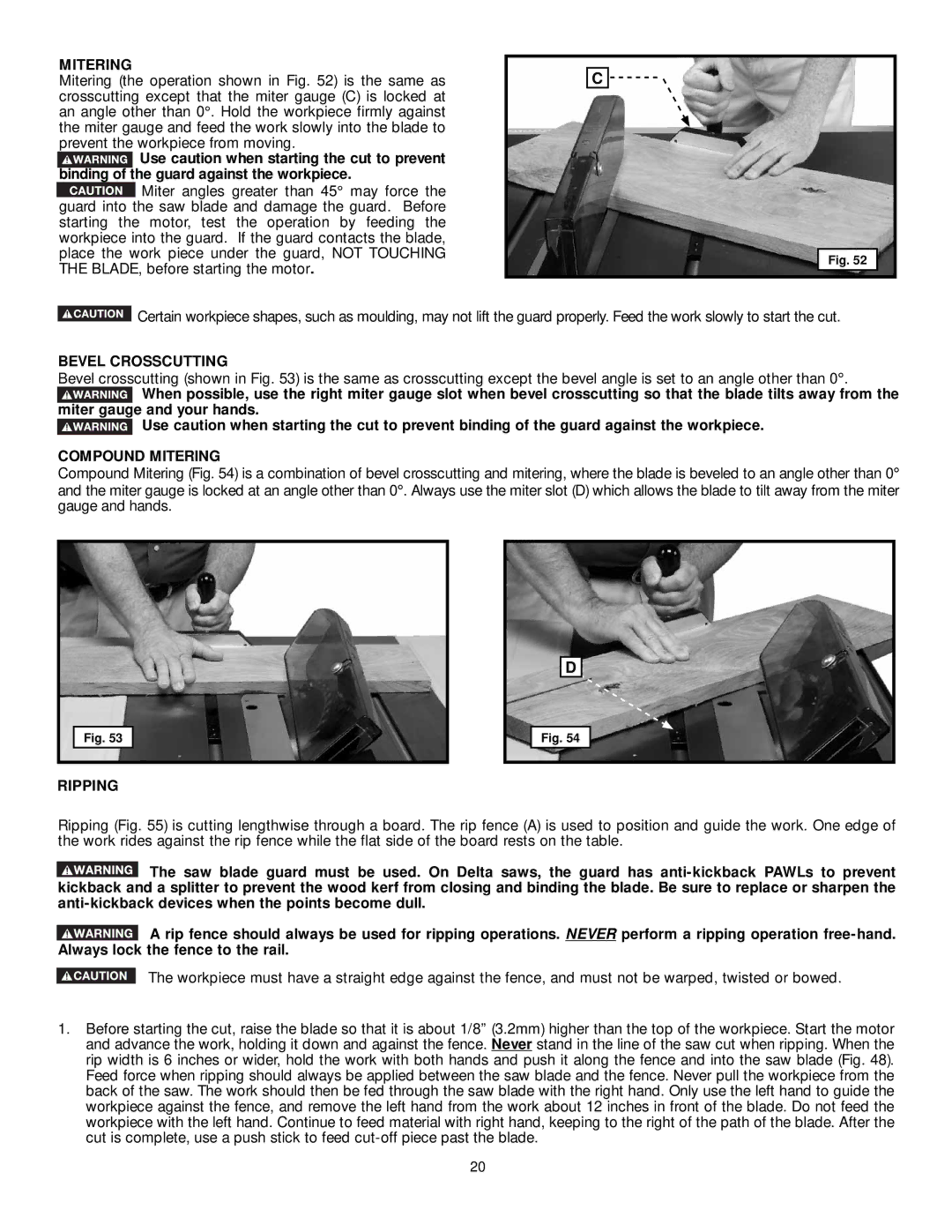
MITERING
Mitering (the operation shown in Fig. 52) is the same as crosscutting except that the miter gauge (C) is locked at an angle other than 0°. Hold the workpiece firmly against the miter gauge and feed the work slowly into the blade to prevent the workpiece from moving.
![]() Use caution when starting the cut to prevent binding of the guard against the workpiece.
Use caution when starting the cut to prevent binding of the guard against the workpiece.
![]() Miter angles greater than 45° may force the guard into the saw blade and damage the guard. Before starting the motor, test the operation by feeding the workpiece into the guard. If the guard contacts the blade, place the work piece under the guard, NOT TOUCHING THE BLADE, before starting the motor.
Miter angles greater than 45° may force the guard into the saw blade and damage the guard. Before starting the motor, test the operation by feeding the workpiece into the guard. If the guard contacts the blade, place the work piece under the guard, NOT TOUCHING THE BLADE, before starting the motor.
C ![]()
![]()
Fig. 52
![]() Certain workpiece shapes, such as moulding, may not lift the guard properly. Feed the work slowly to start the cut.
Certain workpiece shapes, such as moulding, may not lift the guard properly. Feed the work slowly to start the cut.
BEVEL CROSSCUTTING
Bevel crosscutting (shown in Fig. 53) is the same as crosscutting except the bevel angle is set to an angle other than 0°.
![]() When possible, use the right miter gauge slot when bevel crosscutting so that the blade tilts away from the miter gauge and your hands.
When possible, use the right miter gauge slot when bevel crosscutting so that the blade tilts away from the miter gauge and your hands.
Use caution when starting the cut to prevent binding of the guard against the workpiece.
COMPOUND MITERING
Compound Mitering (Fig. 54) is a combination of bevel crosscutting and mitering, where the blade is beveled to an angle other than 0° and the miter gauge is locked at an angle other than 0°. Always use the miter slot (D) which allows the blade to tilt away from the miter gauge and hands.
Fig. 53
D
Fig. 54
RIPPING
Ripping (Fig. 55) is cutting lengthwise through a board. The rip fence (A) is used to position and guide the work. One edge of the work rides against the rip fence while the flat side of the board rests on the table.
![]() The saw blade guard must be used. On Delta saws, the guard has
The saw blade guard must be used. On Delta saws, the guard has
![]() A rip fence should always be used for ripping operations. NEVER perform a ripping operation
A rip fence should always be used for ripping operations. NEVER perform a ripping operation
The workpiece must have a straight edge against the fence, and must not be warped, twisted or bowed.
1.Before starting the cut, raise the blade so that it is about 1/8” (3.2mm) higher than the top of the workpiece. Start the motor and advance the work, holding it down and against the fence. Never stand in the line of the saw cut when ripping. When the rip width is 6 inches or wider, hold the work with both hands and push it along the fence and into the saw blade (Fig. 48). Feed force when ripping should always be applied between the saw blade and the fence. Never pull the workpiece from the back of the saw. The work should then be fed through the saw blade with the right hand. Only use the left hand to guide the workpiece against the fence, and remove the left hand from the work about 12 inches in front of the blade. Do not feed the workpiece with the left hand. Continue to feed material with right hand, keeping to the right of the path of the blade. After the cut is complete, use a push stick to feed
20
